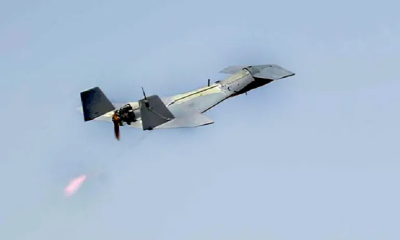Foreign News
Al Jazeera office raided as Israel takes channel off air

Israel’s government has moved to shut down the operations of the Al Jazeera television network in the country, branding it a mouthpiece for Hamas.
Prime Minister Benjamin Netanyahu said the cabinet agreed to the closure while the war in Gaza is ongoing.
Police raided the Qatari broadcaster’s office at the Ambassador hotel in Jerusalem on Sunday.
Al Jazeera called claims it was a threat to Israeli security a “dangerous and ridiculous lie”. The channel said it reserved the right to “pursue every legal step”.
Israel’s Communications Minister Shlomo Karhi said equipment had been taken in the raid. A video posted by the minister on X shows police officers and inspectors from the ministry entering a hotel room.
A BBC team visited the scene, but was prevented from filming or going into the hotel by police.
According to Reuters news agency, the Israeli satellite service Yes displayed a message that read: “In accordance with the government decision, the Al Jazeera station’s broadcasts have been stopped in Israel.”
The blockage is effectively only partial, however, as the channel is still accessible through Facebook in Israel.
The shut down of Al Jazeera in Israel has been criticised by a number of human rights and press groups.
The Association for Civil Rights in Israel (ACRI) said they had filed a request to the country’s Supreme Court to issue an interim order to overturn the ban.
The group said that claims that the broadcaster was a propaganda tool for Hamas were “unfounded”, and that Sunday’s ban was less about security concerns and more to “serve a more politically motivated agenda, aimed at silencing critical voices and targeting Arab media”.
The Foreign Press Association (FPA) urged the Israeli government to reconsider its decision, saying the shut down of Al Jazeera in the country should be “a cause for concern for all supporters of a free press”. The FPA said in a statement that Israel now joins “a dubious club of authoritarian governments to ban the station”, and warned that Mr Netanyahu has the authority to target other foreign outlets that he considers to be “acting against the state”.
The Committee to Protect Journalists’ (CPJ) Program Director Carlos Martinez de la Serna echoed the same concerns, saying: “The Israeli cabinet must allow Al Jazeera and all international media outlets to operate freely in Israel, especially during wartime.”
The UN’s Human Rights office also called the Israeli government to reverse the ban, posting on X: “A free & independent media is essential to ensuring transparency & accountability. Now, even more so given tight restrictions on reporting from Gaza.”

Al Jazeera, which is headquartered in Qatar (pictured here), has condemned Israel’s decision to shut its operations in Israel (BBC)
Foreign journalists are banned from entering Gaza, and Al Jazeera staff there have been some of the only reporters on the ground.
For years, Israeli officials have accused the network of anti-Israeli bias.
Their criticisms of the broadcaster have intensified since the 7 October Hamas attacks on southern Israel, in which about 1,200 people were killed and more than 250 were taken hostage. Some 128 of those hostages are still unaccounted for, with at least 34 presumed dead.
At least 34,683 Palestinians have been killed and 78,018 injured in Israel’s subsequent military campaign in Gaza, according to the Hamas-run health ministry.
Last month, the Israeli parliament passed a law giving the government power to temporarily close foreign broadcasters considered a threat to national security during the war against Hamas.
Qatar, where Al Jazeera is headquartered, is mediating talks between Israel and Hamas over the now almost seven-month-long conflict.
Previous negotiations mediated by Qatar led to a temporary ceasefire and the release of 105 Israeli hostages in November.
Al Jazeera has accused Israel of deliberately targeting its staff.
Journalists including Hamza al-Dahodouh, the son of Al Jazeera Gaza bureau chief Wael al-Dahdouh, have been killed by Israeli strikes. Israel denies targeting journalists.
“Israel’s suppression of free press to cover up its crimes by killing and arresting journalists has not deterred us from performing our duty,” the network said in its response to Sunday’s ban.
(BBC)
Foreign News
Nasa ‘Earthrise’ astronaut dies at 90 in plane crash

Apollo 8 astronaut Bill Anders, who snapped one of the most famous photographs taken in outer space, has died at the age of 90.
Officials say a small plane he was flying crashed into the water north of Seattle, Washington.
Anders’ son Greg confirmed that his father was flying the small plane, and that his body was recovered on Friday afternoon. “The family is devastated. He was a great pilot. He will be missed,” a statement from the family reads.
Anders – who was a lunar module pilot on the Apollo 8 mission – took the iconic Earthrise photograph, one of the most memorable and inspirational images of Earth from space.
Taken on Christmas Eve during the 1968 mission, the first crewed space flight to leave Earth and reach the Moon, the picture shows the planet rising above the horizon from the barren lunar surface.
Anders later described it as his most significant contribution to the space programme.

The image is widely credited with motivating the global environmental movement and leading to the creation of Earth Day, an annual event to promote activism and awareness of caring for the planet.
Speaking of the moment, Anders said: “We came all this way to explore the Moon, and the most important thing that we discovered was the Earth.”
Officials said on Friday that Anders crashed his plane around 11:40PDT (1940BST).
The US National Transportation Safety Board (NTSB) said the 90-year-old was flying a Beechcraft A A 45 – also known as a T-34. The agency said that the plane crashed about 80ft (25m) from the coast of Jones Island.
Anders also served as the backup pilot to the Apollo 11 mission, the name of the effort that led to the first Moon landing on July 24, 1969.
Following Anders’ retirement from the space programme in 1969, the former astronaut largely worked in the aerospace industry for several decades. He also served as US Ambassador to Norway for a year in the 1970s.
But he is best remembered for the Apollo 8 mission and the iconic photograph he took from space.
“In 1968, during Apollo 8, Bill Anders offered to humanity among the deepest of gifts an astronaut can give. He traveled to the threshold of the Moon and helped all of us see something else: ourselves,” Nasa Administrator Bill Nelson said in a statement.
Mark Kelly, a former astronaut who now serves as a US Senator for the state of Arizona, said in a post on X, formerly Twitter, that Anders “inspired me and generations of astronauts and explorers. My thoughts are with his family and friends”.
[BBC]
Foreign News
China’s Chang’e-6 lifts off from far side of Moon with rock samples

A Chinese spacecraft carrying rock and soil samples from the far side of the Moon has lifted off from the lunar surface to start its journey back to Earth, according to state media.
The achievement on Tuesday is a world first and the latest leap for Beijing’s decades-old space programme, which aims to send a crewed mission to the Moon by 2030.
The Xinhua News Agency, citing the China National Space Administration (CNSA), said that the ascender of the Chang’e-6 probe took off at 7:38am local time on Tuesday (23:38 GMT) and entered a preset orbit around the moon.
It described the move as “an unprecedented feat in human lunar exploration history”.
The Chang’e-6 probe was launched last month and its lander touched down on the far side of the Moon on Sunday. It used a drill and robotic arm to dig up soil on and below the Moon’s surface, according to Xinhua.
After successfully gathering its samples, the Chang’e-6 unfurled China’s national flag for the first time on the far side of the Moon, it said.
The agency cited the CNSA as saying that the spacecraft stowed the samples it had gathered in a container inside the ascender of the probe as planned.
[Aljazeera]
Foreign News
China says its spacecraft lands on Moon’s far side

China says its uncrewed craft has successfully landed on the far side of the Moon – an unexplored place almost no-one tries to go.
The Chang’e 6 touched down in the South Pole-Aitken Basin at 06:23 Beijing time on Sunday morning (22:23 GMT Saturday), the China National Space Administration (CNSA) said.
Launched on 3 May, the mission aims to collect precious rock and soil from this region for the first time in history. The probe could extract some of the Moon’s oldest rocks from a huge crater on its South Pole.
The landing was fraught with risks, because it is very difficult to communicate with spacecraft once they reach the far side of the Moon. China is the only country to have achieved the feat before, landing its Chang’e-4 in 2019.
After launching from Wenchang Space Launch Center, the Chang’e 6 spacecraft had been orbiting the Moon waiting to land. The lander component of the mission then separated from the orbiter to touch down on the side of the Moon that faces permanently away from Earth.
During the descent, an autonomous visual obstacle avoidance system was used to automatically detect obstacles, with a visible light camera selecting a comparatively safe landing area based on the brightness and darkness of the lunar surface, the CNSA was quoted as saying by state-run Xinhua news agency.
The lander hovered about 100m (328ft) above the safe landing area, and used a laser 3D scanner before a slow vertical descent. The operation was supported by the Queqiao-2 relay satellite, the CNSA said.
Chinese state media described the successful landing as an “historic moment”. The state broadcaster said “applause erupted at the Beijing Aerospace Flight Control Center” when the Chang’e landing craft touched down on the Moon early on Sunday morning.
The lander should spend up to three days gathering materials from the surface in an operation the CNSA said would involve “many engineering innovations, high risks and great difficulty”. “Everyone is very excited that we might get a look at these rocks no-one has ever seen before,” explains Professor John Pernet-Fisher, who specialises in lunar geology at the University of Manchester.
He has analysed other lunar rock brought back on the American Apollo mission and previous Chinese missions. But he says the chance to analyse rock from a completely different area of the Moon could answer fundamental questions about how planets form.
Most of the rocks collected so far are volcanic, similar to what we might find in Iceland or Hawaii. But the material on the far side would have a different chemistry . “It would help us answer those really big questions, like how are planets formed, why do crusts form, what is the origin of water in the solar system?” the professor says.
The mission aims to collect about 2kg (4.4lb) of material using a drill and mechanical arm, according to the CNSA.
The South Pole–Aitken basin, an impact crater, is one of the largest known in the solar system.
From there, the probe could gather material that came from deep inside the lunar mantle – the inner core of the Moon – Prof Pernet-Fisher says.
The Moon’s South Pole is the next frontier in lunar missions – countries are keen to understand the region because there is a good chance it has ice.

The capsule in the last Chinese moon mission, Chang’e 5, brought back soil and rocks in 2020 (BBC)
Access to water would significantly boost the chances of successfully establishing a human base on the Moon for scientific research.
If the mission succeeds, the craft will return to Earth with the precious samples on board a special return capsule.
The material will be kept in special conditions to try to keep it as pristine as possible.
Scientists in China will be given the first chance to analyse the rocks, and later researchers around the world will be able to apply for the opportunity too.
This is the second time China has launched a mission to collect samples from the Moon.
In 2020 Chang’e 5 brought back 1.7kg of material from an area called Oceanus Procellarum on the Moon’s near side.
China is planning three more uncrewed missions this decade as it looks for water on the Moon and investigates setting up a permanent base there.
Beijing’s broader strategy aims to see a Chinese astronaut walk on the moon by around 2030.
The US also aims to put astronauts back on the moon, with Nasa aiming to launch its Artemis 3 mission in 2026.
(BBC)
























